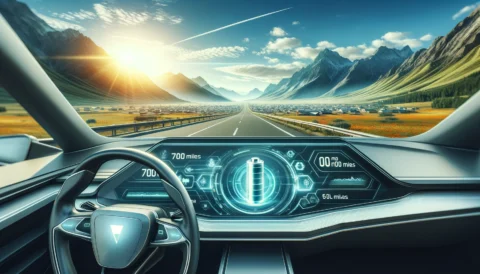 In a significant leap for electric vehicle (EV) technology, researchers at Stanford University have unveiled a groundbreaking lithium metal battery that could potentially double the driving range of EVs to an impressive 700 miles on a single charge. This advancement not only addresses the perennial issue of range anxiety but also promises a more efficient and sustainable future for electric transportation.
In a significant leap for electric vehicle (EV) technology, researchers at Stanford University have unveiled a groundbreaking lithium metal battery that could potentially double the driving range of EVs to an impressive 700 miles on a single charge. This advancement not only addresses the perennial issue of range anxiety but also promises a more efficient and sustainable future for electric transportation.
The Science Behind the Breakthrough
The new lithium metal battery technology builds upon the traditional lithium-ion batteries but introduces a novel approach to dealing with the common degradation issues. In conventional lithium-ion batteries, continuous charging and discharging cycles cause lithium metal bits to become isolated and trapped in the solid electrolyte interphase (SEI), which forms a non-conductive matrix around the anode. This phenomenon, known as “dead lithium,” significantly reduces the battery’s capacity over time.
However, the Stanford team discovered that allowing the battery to rest while fully discharged could mitigate this problem. When the battery is idle in a discharged state, some of the SEI matrix dissolves, allowing the isolated lithium to reconnect with the anode during recharging. This reconnection effectively “revives” the dead lithium, thereby restoring the battery’s capacity and extending its lifespan.
Implications for Electric Vehicles
Implementing this new battery technology could revolutionize the EV market. The increased range—up to 700 miles per charge—could eliminate the range anxiety that deters many potential buyers from transitioning to electric vehicles. This enhancement in battery life and performance does not require expensive new materials or manufacturing techniques; instead, it leverages existing infrastructure with a new battery management protocol. This makes the technology both cost-effective and easy to implement in current EV models.
Economic and Environmental Impact
The potential economic benefits of this advancement are substantial. By doubling the range of EVs, manufacturers can reduce the frequency and cost of recharging, making electric vehicles more appealing and practical for long-distance travel. Additionally, this innovation supports the broader goals of reducing greenhouse gas emissions and dependence on fossil fuels. As EVs become more viable for everyday use, including longer commutes and road trips, the shift towards a more sustainable transportation system accelerates.
Challenges and Future Directions
Despite its promising potential, the road to commercializing this technology is not without challenges. The primary concern lies in the durability and long-term reliability of the new batteries. While initial tests have shown that resting the battery in a discharged state can recover lost capacity, more extensive real-world testing is needed to confirm these results over prolonged periods and varied conditions.
Furthermore, integrating this technology into existing EVs will require updates to the battery management systems. These systems must be programmed to manage the discharge and rest cycles effectively, ensuring optimal performance and longevity.
The Stanford lithium metal battery breakthrough represents a significant milestone in the evolution of electric vehicle technology. By potentially doubling the driving range of EVs, this innovation addresses one of the most significant barriers to widespread adoption—range anxiety. As research progresses and the technology is refined, it holds the promise of transforming the EV landscape, making electric vehicles a more attractive, sustainable, and practical option for consumers worldwide.
The development of these advanced batteries underscores the critical role of continuous innovation in achieving a sustainable future. With further research and collaboration between academia, industry, and policymakers, the vision of a world where electric vehicles dominate the roads, significantly reducing our carbon footprint, moves closer to reality.
References:
- SciTechDaily. (2024). Stanford Lithium Metal Battery Breakthrough Could Double the Range of Electric Vehicles.
- Interesting Engineering. (2024). Stanford scientists unlock 700 mile range EV with battery nap.
- The Brighter Side. (2024). Cutting-edge battery doubles electric vehicle range to 700 miles on a single charge.



